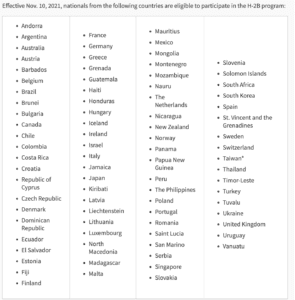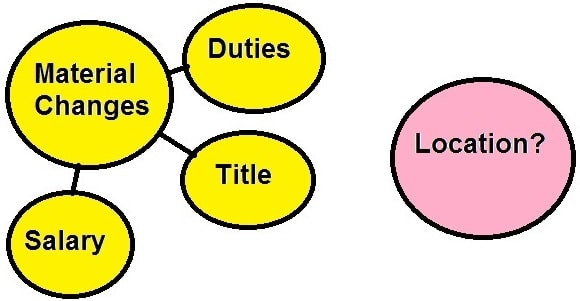- the employee’s purpose of going there is to participate in a staff seminar, management conference, or other employee-development activities;
- the employee will only spend a little time at any one location; or
- the job is “peripatetic in nature.” The USCIS defines peripatetic jobs as:
Such situations where [the employee’s] primary job is at one location but there is a need to embark on occasional travel for short periods to other locations on a casual, short-time basis, which can be recurring but not excessive.
- Specifically, one time visit by a peripatetic worker to such other locations should not exceed 5 consecutive days. As for workers who spend most work time at one worksite and travel occasionally to other locations, one time travel to such locations must not exceed 10 days.
Penalties for Not Filing an Amendment for Location Change When Necessary
If an H-1B amended petition for change of worksite locations is required and is not obtained, the consequences can be felt by both the employer and employee. For instance, the employee may lose his or her H-1B status and face deportation. It is therefore very important for employers to have a good understanding of the USCIS regulations regarding petition amendments.
When Should an Employer Submit the Amended Petition for Change of Worksite Locations?
Going by the Administrative Appeals Office (AAO) decision in 2015 , employers are required to apply for an amendment when there is a material change to the initial petition. But, it did not expressly clarify if they should file the amendment before the movement takes place.
However, to be on the safe side, it is advisable that employers promptly notify the USCIS of any material change. So, therefore, it is recommended to file the amendment before the employee moves. In the event that the move has already taken place, the employer should start the amendment process as soon as possible.
How to File H-1B Amended Petition for Location Change
To apply for an H-1B amendment, the employer will need to submit an I-129 form to the USCIS.
To start, the employer should gather all the necessary information about the relocation, and include them in the H-1B Labor Condition Application (LCA) . Typically, the Department of Labor (DOL) makes a decision on these cases within one week.
The next thing is to prepare the I-129 petition as well as other necessary supporting documents for the case such as:
- the employee’s H-1B visa
- a copy of the employee’s passport
- a copy of the employee’s I-94 form
- a copy of the H-1B employee’s updated resume
- copies of the employee’s three most recent payslips
- copies of the employee’s education degree
- the employee’s work itinerary
If you are using H-1B premium processing , you will need to submit an I-907 form with the petition.
H-1B Amendment FAQs
Should the amended petition be approved before an H-1B worker can move to a new location?
Again, the AAO decision is also silent on this question as it did not clarify whether employers should wait for approval of the amended petition before moving an employee to a new worksite location. However, an employer should at least try to submit the amendment before the move takes place. With that, the action will be easier to defend if the employer and/or employee are questioned during the USCIS worksite visit to their office.
What If the amended petition is denied?
If the amended H-1B petition is denied , it will not in any way affect the employee’s legal immigration status at the job location listed in the initial petition. With this, the H-1B worker will be able to return to the original worksite location and continue their job as long as the original H-1B petition is still valid.
Can I file another amended H-1B petition for location change if I still have an amended petition pending?
Yes, an employer can file another amended petition for change of worksite locations for an H-1B employee even if there is still another pending amended petition which the USCIS has not made a decision on. However, each amended petition must meet the criteria for H-1B classification. Also, keep in mind that, if the employee’s H-1B status expires while those petitions are still pending, the denial of any of the amended petitions will lead to the denial of all successive amended petitions.
What is the H-1B Amendment Processing Time?
Like the original H-1B petition, your amendment processing time will depend on the caseload of the service center that is processing it. A general rule of thumb is this: the closer it is to the H-1B filing season (April) the longer it will take to process your amendment. On average, it can take between 4 and 6 months to process your H-1B amendment, though it can take more or less time given the circumstances. Alternatively, you may be able to file the amendment with premium processing to reduce the processing time to 15 calendar days.
Other H-1B Topics

- ← Previous Bannon convicted for contempt of Congress; suit targets Skittles ingredient
- Next → IP Goes Pop! – Inventing For Kids of All Ages With the USPTO
Editorial Staff
The American Legal Journal Provides The Latest Legal News From Across The Country To Our Readership Of Attorneys And Other Legal Professionals. Our Mission Is To Keep Our Legal Professionals Up-To-Date, And Well Informed, So They Can Operate At Their Highest Levels.
Related
Republicans Can Find a Concrete Win in Stripping Sanctuary City Grants
Recently, House Republicans have placed Secretary Mayorkas in the crosshairs of a concerted impeachment effort. This comes alongside the end

USCIS Urges Applicants to Complete I-693 Medical Forms ASAP for More Efficient Processing — Visa Lawyer Blog — June 27, 2022
Welcome back to a brand-new week. We have some interesting news for employment-based adjustment of status applicants. Today, Monday, June

Additional H-2B Visa Available for Second Half of 2022
Many business owners and employers in the U.S. will be happy to know that the Department of Homeland Security and
Leave a Reply Cancel reply
You must be logged in to post a comment.
Summer Issue Coming June 30th

Recent Posts
- Tampa Student Loan and Bankruptcy Lawyer Blog — September 20, 2020
- What happens to assets that I leave out of my living trust?
- Anatomy of a Data Center — Gravel2Gavel Construction & Real Estate Law Blog — September 20, 2024
- Maternity Wing Closures: Insights and Impact
- It’s easier than you think to prepare for retirement
Email : contact@americanlegaljournal.com
Address:
1321 Upland Dr. PMB 20455
Houston, Texas 77043-4718Policies
- About
- Masthead
- Editorial Guidelines
- Ethics Policy
- Corrections Policy
- Byline Policy
- Diversity Policy
- Contact Us
Legal
- Privacy & CCPA Policy
- Website Disclaimer
- Terms & Conditions
- DMCA Notice
- Accessibility Policy
